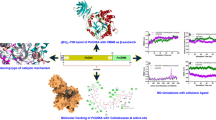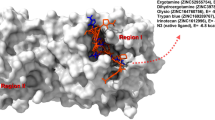Abstract
Rv0045c is an esterase involved in lipid metabolism of Mycobacterium tuberculosis. It belongs to the α/β hydrolase family. In the current study, we performed sequence- and structure-based analysis of Rv0045c followed by molecular dynamics (MD) simulation for 100 ns to investigate conformational changes in the enzyme. Sequence analysis revealed that this enzyme is possibly a hormone-sensitive lipase. Further, through structural analysis, a putative catalytic tetrad containing “Ser-Asp-Ser-His” and residues involved in the formation of an oxyanion hole were identified. MD simulation of Rv0045c revealed a conformational transition from an open to a closed state. The active site pocket was found to be gated by four loops. The potential role of the cap domain and the mobile histidine is discussed. From the simulation, we see that the conformational changes mimic the different stages in the reaction mechanism of Rv0045c. These results support the hypothesis that free enzyme simulation encompasses all the conformations necessary for the different stages of catalysis. Our findings add to the growing knowledge of an important family of esterases in Mycobacterium tuberculosis.

Sequence and structural analysis of Rv0045c




Similar content being viewed by others
References
Brockerhoff H (2012) Lipolytic enzymes. Elsevier, Amsterdam
Hemila H, Koivula TT, Palva I (1994) Hormone-sensitive lipase is closely related to several bacterial proteins, and distantly related to acetylcholinesterase and lipoprotein lipase: identification of a superfamily of esterases and lipases. Biochim Biophys Acta Lipids Lipid Metab 1210:249–253. doi:10.1016/0005-2760(94)90129-5
Schweiger M, Schreiber R, Haemmerle G, Lass A, Fledelius C, Jacobsen P et al (2006) Adipose triglyceride lipase and hormone-sensitive lipase are the major enzymes in adipose tissue triacylglycerol catabolism. J Biol Chem 281:40236–40241. doi:10.1074/jbc.M608048200
Bornscheuer UT, Kazlauskas RJ (2006) Lipases and esterases: sections 5.3‐5.4. Wiley-VCH, Weinheim, pp 141–183
Guo J, Zheng X, Xu L, Liu Z, Xu K, Li S et al (2010) Characterization of a novel esterase Rv0045c from Mycobacterium tuberculosis. PLoS One 5:e13143. doi:10.1371/journal.pone.0013143
Zheng X, Guo J, Xu L, Li H, Zhang D, Zhang K et al (2011) Crystal structure of a novel esterase Rv0045c from Mycobacterium tuberculosis. PLoS One 6:e20506. doi:10.1371/journal.pone.0020506
Morris GM, Goodsell DS, Huey R, Lindstrom W, Hart WE, Kurowski S et al (2010) AutoDock v4. 2. http://autodock.scripps.edu/
Hekkelman ML, te Beek TA, Pettifer SR, Thorne D, Attwood TK, Vriend G (2010) WIWS: a protein structure bioinformatics Web service collection. Nucleic Acids Res 38:W719–W723. doi:10.1093/nar/gkq453
DeLano WL (2002) The PyMOL molecular graphics system. DeLano Scientific, Palo Alto, CA. http://www.pymol.org
Fiser A, Sali A (2003) ModLoop: automated modeling of loops in protein structures. Bioinformatics 19(18):2500–2501. doi:10.1093/bioinformatics/btg362
Hess B, Kutzner C, Van Der Spoel D, Lindahl E (2008) GROMACS 4: algorithms for highly efficient, load-balanced, and scalable molecular simulation. J Chem Theory Comput 4:435–447. doi:10.1021/ct700301q
Teresa P, Alexandra E, Diana G, Martin BU, Peter JP (2014) Efficient characterization of protein cavities within molecular simulation trajectories: trj_cavity. J Chem Theory Comput 10(5):2151–2164. doi:10.1021/ct401098b
Park SY, Lee SH, Lee J, Nishi K, Kim YS, Jung CH, Kim JS (2008) High-resolution structure of ybfF from Escherichia coli K12: a unique substrate-binding crevice generated by domain arrangement. J Mol Biol 376:1426–1437. doi:10.1016/j.jmb.2007.12.062
Krem MM, Di Cera E (2001) Molecular markers of serine protease evolution. EMBO J 20:3036–3045. doi:10.1093/emboj/20.12.3036
McCulloch KM, Mukherjee T, Begley TP, Ealick SE (2010) Structure determination and characterization of the vitamin B6 degradative enzyme (E)-2-(acetamidomethylene) succinate hydrolase. Biochemistry 49:1226–1235. doi:10.1021/bi901812p
Ben Ali Y, Chahinian H, Petry S, Muller G, Lebrun R, Verger R et al (2006) Use of an inhibitor to identify members of the hormone-sensitive lipase family. Biochemistry 45:14183–14191. doi:10.1021/bi0613978
Ash EL, Sudmeier JL, Day RM, Vincent M, Torchilin EV, Haddad KC et al (2000) Unusual 1H NMR chemical shifts support (His) Cε 1—H⋯O== C H-bond: proposal for reaction-driven ring flip mechanism in serine protease catalysis. Proc Natl Acad Sci USA 97:10371–10376. doi:10.1073/pnas.97.19.10371
Bachovchin WW (1986) Nitrogen-15 NMR spectroscopy of hydrogen-bonding interactions in the active site of serine proteases: evidence for a moving histidine mechanism. Biochemistry 25:7751–7759. doi:10.1021/bi00371a070
Ma B, Nussinov R (2010) Enzyme dynamics point to stepwise conformational selection in catalysis. Curr Opin Chem Biol 14:652–659. doi:10.1016/j.cbpa.2010.08.012
Pentikäinen U, Pentikäinen OT, Mulholland AJ (2008) Cooperative symmetric to asymmetric conformational transition of the apo‐form of scavenger decapping enzyme revealed by simulations. Proteins: Struct Funct Bioinf 70(2):498–508. doi:10.1002/prot.21540
McGeagh JD, Ranaghan KE, Mulholland AJ (2011) Protein dynamics and enzyme catalysis: insights from simulations. Biochim Biophys Acta Proteins Proteomics 1814(8):1077–1092. doi:10.1016/j.bbapap.2010.12.002
Hedstrom L (2002) Serine protease mechanism and specificity. Chem Rev 102(12):4501–4524. doi:10.1021/cr000033x
Dodson G, Wlodawer A (1998) Catalytic triads and their relatives. Trends Biochem Sci 23(9):347–352. doi:10.1016/S0968-0004(98)01254-7
Perona JJ, Craik CS, Fletterick RJ, Singer PT (1993) Locating the catalytic water molecule in serine proteases. Science 261:620–620. doi:10.1126/science.8342029\
Hammes GG, Chang YC, Oas TG (2009) Conformational selection or induced fit: a flux description of reaction mechanism. Proc Natl Acad Sci USA 106(33):13737–13741. doi:10.1073/pnas.0907195106
Eisenmesser EZ, Millet O, Labeikovsky W, Korzhnev DM, Wolf-Watz M, Bosco DA, Kern D (2005) Intrinsic dynamics of an enzyme underlies catalysis. Nature 438(7064):117–121. doi:10.1038/nature04105
Acknowledgment
The authors thank the Biotechnology Information System (BTIS), Department of Biotechnology for computational facilities.
Author information
Authors and Affiliations
Corresponding author
Electronic supplementary material
Below is the link to the electronic supplementary material.
ESM 1
(PDF 1014 kb)
The video shows the transition from open to closed state. The structure of Rv0045c is shown in surface representation and colored cyan, the active site region is red, the gating loop 190–205 is in magenta, loop 221–225 in orange, loop 278–284 in green and loop 305–310 in blue. (MP4 7853 kb)
Movie S2
The video showing the movement of the gating loops and the histidine flipping during the transition from open to close state. The structure of Rv0045c is shown in cartoon representation, the surface loops responsible for the closure loop 190–205 is in yellow, loop 221–225 is in blue, loop 278–284 in magenta and loop 305–310 in orange. The catalytic triad is shown in stick representation and coloured red. (MP4 8009 kb)
The video shows the close up view of catalytic histidine undergoing flipping (for clarity only the catalytic residues are shown). (MP4 9649 kb)
Rights and permissions
About this article
Cite this article
Sherlin, D., Anishetty, S. Mechanistic insights from molecular dynamic simulation of Rv0045c esterase in Mycobacterium tuberculosis . J Mol Model 21, 90 (2015). https://doi.org/10.1007/s00894-015-2630-4
Received:
Accepted:
Published:
DOI: https://doi.org/10.1007/s00894-015-2630-4




